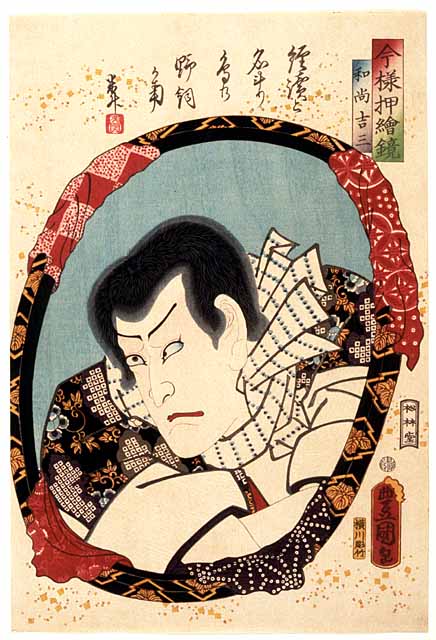
Ichikawa Kodanji IV (Beisho) as Osho Kichisa in Sannin Kichisa kuruwa no hatsugai, performed at the Ichimura theatre from 01/14/1860
Given by the Friends of the Fitzwilliam with the aid of the MGC Purchase Grant Fund and the National Art Collections Fund. From the series Imayo oshi-e kagami (Up-to-date Padded Pictures in Mirrors). Kunisada designed several series of portraits of actors reflected in mirrors. Six prints from this series are included in this exhibition.
This print commemorates the first performance of this kizewamono (raw domestic drama), written by Kawatake Mokuami. The main strand of the plot concerns three honourable thieves, each of whom is called Kichisa. They swear blood brotherhood and end up killing each other rather than give themselves up to the police. Ishikawa Kodanji IV took the part of the ex-priest Osho Kichisa.
This is from a luxury edition on thick paper with special printing effects, including blind embossing (karazuri), textile embossing (nunome-zuri) on the neckerchief and burnishing (tsuya-zuri) on the black. The seal of the leading block-carver Yokokawa Takejiro appears on the print.
Collections Record: P.78-1999
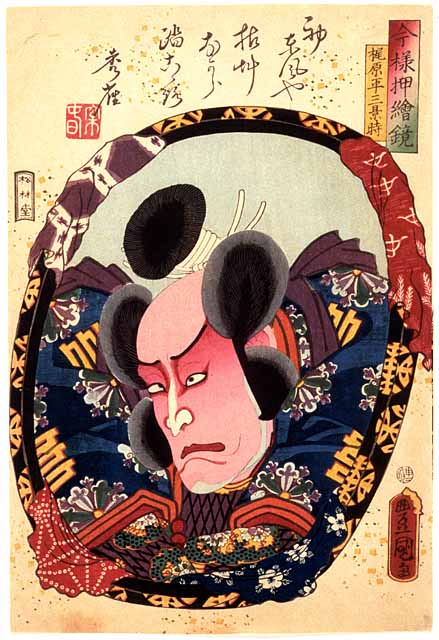
Nakamura Shujaku (Tsuruzo I) as Kajiwara Heiza Kagetoki
02/1860
Given by the Friends of the Fitzwilliam with the aid of the MGC Purchase Grant Fund and the National Art Collections Fund.
From the series Imayo oshi-e kagami (Up-to-date Padded Pictures in Mirrors). Kunisada designed several series of portraits of actors reflected in mirrors. Six prints from this series are included in this exhibition.
Kajiwara Kagetoki was a 12th-century warrior who deserted the Heike clan to join the Genji. Often depicted as a villain, he was the hero of the play premiered in 1730 as Miura no Osuke kobai tazuna, the third act of which is still performed today and tells how Kagetoki proves the power of a Genji heirloom sword.
In contrast to the other prints included in this exhibition, this example is not from a luxury edition; it is printed with cheaper colours on thinner paper, without special additional printing effects such as embossing and burnishing. No block-carver’s seal appears on the print.
Collections Record: P.79-1999
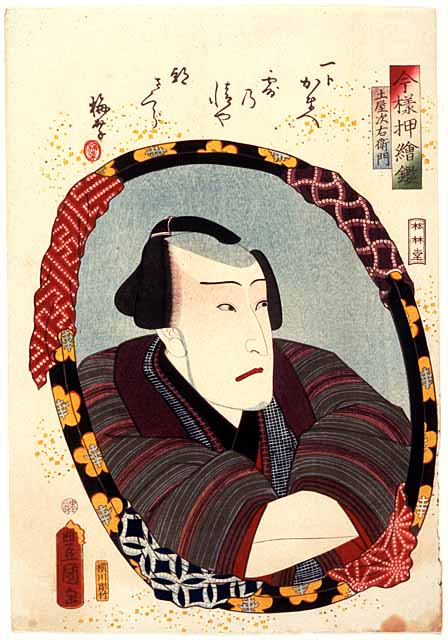
Onoe Baiko (Jitsukawa Enjaku I) as Tsuchiya Jiemon in Koi-bikyaku Yamato orai, performed at the Nakamura theatre from 09/03/1860
Given by the Friends of the Fitzwilliam with the aid of the MGC Purchase Grant Fund and the National Art Collections Fund.
From the series Imayo oshi-e kagami (Up-to-date Padded Pictures in Mirrors). Kunisada designed several series of portraits of actors reflected in mirrors. Six prints from this series are included in this exhibition.
This actor appeared only briefly with the name Onoe Baiko and is not therefore counted among the official lineage of the Onoe family. He had been adopted by Onoe Kikugoro IV in 1859, but the relationship was soon severed and he returned to his original adoptive father, Jitsukawa Enzaburo I, in his native Osaka, assuming the name Jitsukawa Enjaku I in 1863.
This play was one of several kabuki versions of the puppet play by Chikamatsu Monzaemon telling the story of how Chubei was compromised by his blind love for Umegawa, a prostitute at the brothel owned by Tsuchiya Jiemon, who is depicted in this print.
The printing includes burnishing (tsyra-zuri) on the black. The seal of the leading block-carver Yokokawa Takejiro appears on the print.
Collections Record: P.80-1999
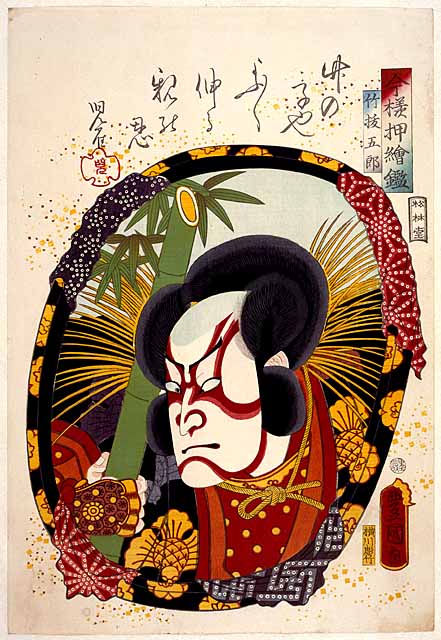
Nakamura Fukusuke I as Soga no Goro in Yayoi-zakura hisago no makubari , performed at the Nakamura theatre from 09/03/1860
Given by the Friends of the Fitzwilliam with the aid of the MGC Purchase Grant Fund and the National Art Collections Fund.
From the series Imayo oshi-e kagami (Up-to-date Padded Pictures in Mirrors). Kunisada designed several series of portraits of actors reflected in mirrors. Six prints from this series are included in this exhibition.
This print of ‘bamboo-tugging Goro’ illustrates the scene in this Spring play (yayoi kyogen) in which the dance skit Edo-ganoko ninin Dojo-ji is performed.
The printing includes burnishing (tsuya-zuri) on the black. The seal of the leading block-carver Yokokawa Takejiro appears on the print.
Collections Record: P.81-1999
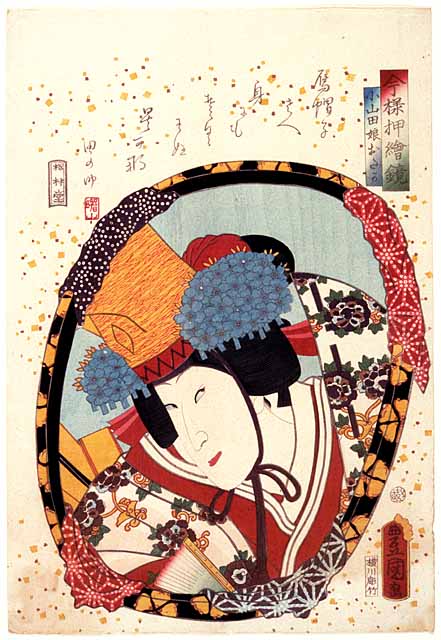
Sawamura Tanosuke III as Otaka, daughter of Oyamada, in Chushin akatsuki no tori, performed at the Morita theatre from 05/05/1860
Given by the Friends of the Fitzwilliam with the aid of the MGC Purchase Grant Fund and the National Art Collections Fund.
From the series Imayo oshi-e kagami (Up-to-date Padded Pictures in Mirrors). Kunisada designed several series of portraits of actors reflected in mirrors. Six prints from this series are included in this exhibition.
Sawamura Tanosuke III (1845-78) was one of the leading onnagata (female-role actors) of his generation. When this print was made he had just become ‘head onnagata’ (tate onnagata) at the Morita theatre at the age of fifteen. His good looks and sex appeal assured him a large number of followers and his name became attached to numerous female hair and fashion accessories, including the Tanosuke mage (topknot), the Tanosuke eri (collar) and the Tanosuke geta (clog).
In 1865 he became ill with gangrene, and two years later his hand and foot were amputated. He continued acting for another four years, then retired and died at the age of 33 after going insane.
The printing here includes blind embossing (karazuri), textile embossing (nunome-zuri) in the background of the floral garment, burnishing (tsuya-zuri) on the black part of the mirror, and mica on the blue hair ornament. The seal of the block-carver Yokokawa Takejiro appears on the print.
Collections Record: P.82-1999
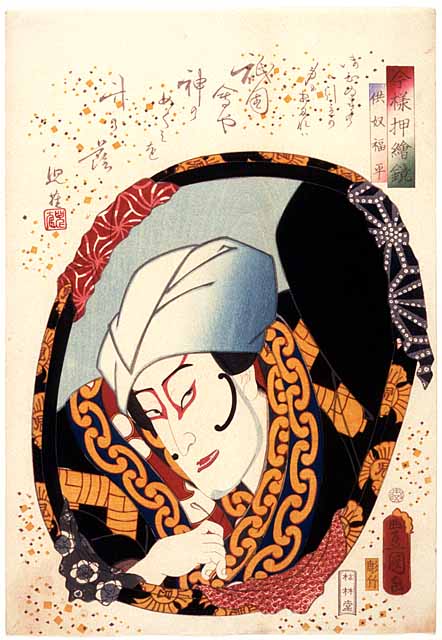
Nakamura Fukusuke I (Shikan IV) as Tomo-yakko Fukuhei
08/1860
Given by the Friends of the Fitzwilliam with the aid of the MGC Purchase Grant Fund and the National Art Collections Fund.
From the series Imayo oshi-e kagami (Up-to-date Padded Pictures in Mirrors). Kunisada designed several series of portraits of actors reflected in mirrors. Six prints from this series are included in this exhibition.
The act entitled Tomo yakko was a Yakko mono (‘footman play’) that originally formed part of the quick-change dance play Nijiri Gaki Nanatsu Iroha. The role of the footman was made famous in 1828 by its first exponent Shikan II (adoptive father of Fukusuke I), so Tomo Yakko was sometimes known as the ‘Shikan play’ (Shikan mono) and the character usually wore the Shikan mon (crest) on his costume. The piece involves the colourfully dressed footman, something of a dandy, performing a dance with exaggerated steps (tanzen roppo).
The printing includes blind embossing (karazuri) and burnishing (tsuya-zuri) on the black. The seal of the leading block-carver Yokokawa Takejiro appears on the print.
Collections Record: P.83-1999
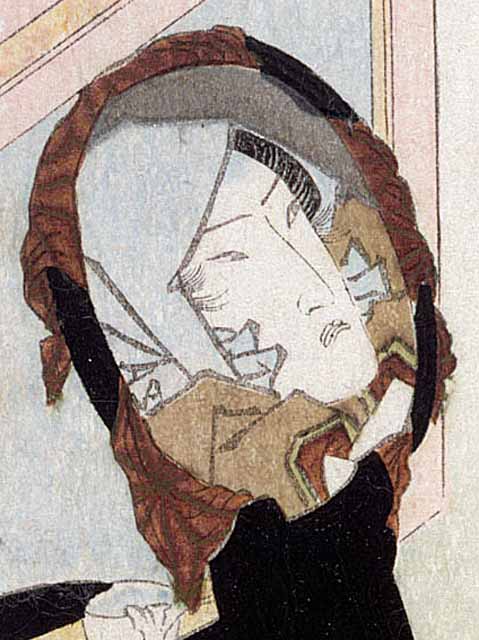
Flower
circa 1823-5
Given to the Fitzwilliam Museum by E. Evelyn Barron in 1937
This is the ‘Flower’ print from a series of surimono titled Kacho-fugetsu (Flower and bird, wind and moon). The butterfly is the seal of the kyoka circle associated with the poet Ryuotei Edo no Hananari, who commissioned the print (the print was also issued without the seal). The woman imagines that she sees the face of her lover, whom she is longing to meet, appear in her mirror. She is holding a folded yukata and may be about to go to the bath-house. The ‘Wind’ print from the series shows a courtesan awaiting her patron.The poem by Ryuotei Edo no Hananari reads:
By a subtle fragrance of flowers, my heart is so distracted and scattered,
like dishevelled hair it is impossible to fix -
the dawn in spring is so enchanting and impossible to describe.
Collections Record: P.489-1937
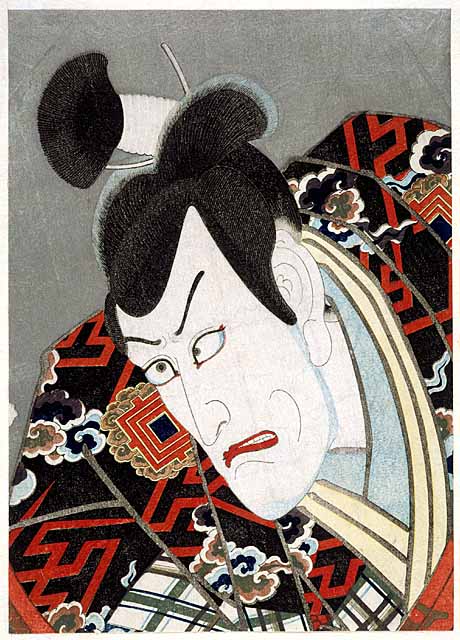
Ichikawa Ebizo V (formerly Danjuro VII) as Fuwa Banzaemon seen in a mirror
circa 1849
Given to the Fitzwilliam Museum by E. Evelyn Barron in 1937
Fragment of a much larger surimono made for the Go poetry group, with a text of poems praising the actor, and the image of a peony (one of the Ichikawa family symbols) designed by Totoya Hokkei (1780-1850). The complete print bears Kunisadas seal reading Kunisada aratame ni-sei Toyokuni no in (Seal of Kunisada changing to Toyokuni II), which records his adoption of his master Toyokunis name in New Year 1844. The print was probably designed in 1849, when his son Danjuro VIII went to visit his father Ichikawa Ebizo V (formerly Danjuro VII) in exile in Osaka. Danjuro VII had been banished from Edo by the government (bakufu) in 1842 in punishment for his luxurious lifestyle as part of the Tempo reforms. The print shows Danjuro VII in one of his most famous roles, which was depicted many times in prints with the characteristic lightning-in-the-clouds pattern on Fuwa Banzaemons costume. The device of portraying an actor reflected in a mirror was used by Kunisada many times.
Collections Record: P.516-1937
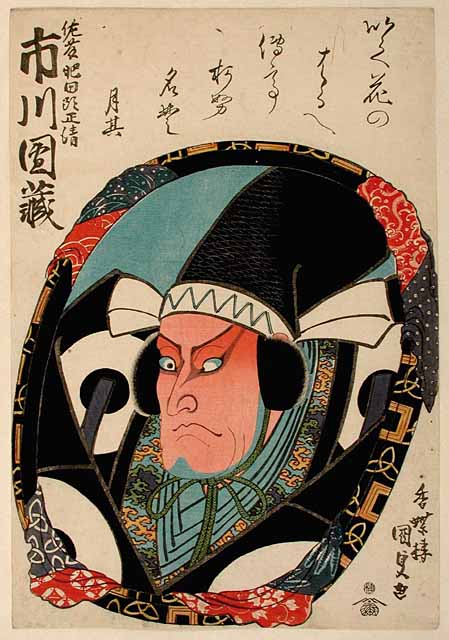
Ichikawa Danzo V as Sato Masakiyo in Hachijin shugo no Honjo (Battle formations in defence of Honjo Castle) performed at the Ichimura Theatre in 01/1833
Private collection
From an untitled set of over forty actor portraits, each reflected in a round mirror resting in a lacquer case, with a poem from the actor’s own brush inscribed above the mirror. Kunisada had previously used a round-mirror format in the early 1820s for a set of beauties reflected in round hand-mirrors. In the late 1820s he applied the format to actor portraiture for the first time in this set, which was issued over a number of years. It was Kunisada’s largest set of actor portraits before the late 1840s, and included many lesser-known performers in addition to stars. He used this mirror format again for sets of actor-portraits in the late 1840s and late 1850s.The hero Sato Masakiyo (actually the historical figure Kato Kiyomasa) is shown in the ‘Poisoned Sake’ (Dokushu) scene of the play: he has been forced into a position where he must take a slow-acting but fatal poison in place of his lord, Oda Haruwaka (actually Toyotomi Hideyori), in order to protect him. The title of the play refers to another act of the play in which Honjo Castle in Kumamoto is attacked by Tomimasa (actually Tokugawa Ieyasu). The identity of such historical characters was disguised to avoid infringing the ban on their portrayal on stage or in prints.



